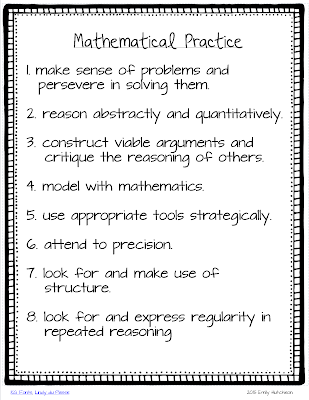The summer began with a professional development by Math Solutions. The people that brought us Number Talks by Sherry Parrish and About Teaching Mathematics by Marilyn Burns. It has been a few weeks now and I still feel like I am wrapping my head around the training.
It was strong.
Everything that we learned about in the PD was rooted in the 8 mathematical practices. Which I must admit, are not a strength of mine...yet. I have been very focused on Common Core standards, guided math, differentiation, and numbers sense in my math studies.
But before the training started I dug out a file I had found from North Carolina about "Unpacking Content." This document takes the 8 mathematical practices and "unpacks" them for each grade level. Looking at the first grade version really helped me to understand how it would look and be applied with my firsties.
Now...I still cannot recite the practices...yet...but after reading the North Carolina packet and the 4 day training, my understanding is much stronger. To keep up this momentum and ensure that I focus on them, I want them posted for me to utilize (click on image for a copy to print):
When looking at what these practices are asking students to do and reflecting on the professional development, my teammate and I were reassured that our focus on conceptual knowledge along with the procedural knowledge is the right path to be on. Students do need to know procedures and facts but they must have the understanding behind them. They must understand the why.
One way that Jess and I have been working toward this mathematical understanding is through Number Talks. Math Solutions also publishes a book called "Classroom Discussion in Math." Within this book, talk moves are explained. These are "moves" to help us, the teachers, guide our students towards making sense of math. It supports the mathematical practices #1, #2, and #3.
The talk moves include:
revoicing
repeating
reasoning
adding on
wait time
When revoicing the teacher is merely confirming that what was said by the student was correctly understood by the teacher. If it wasn't, the student can then elaborate or restate.
Repeating is actually done by another student. You ask another student to repeat what a peer has said but in their own words. This can be a CHALLENGE (double underline here). My hope is that it will support that language development that my students desperately need.
Reasoning is another language building move because the teacher is asking a student if they agree or disagree with a peer's thinking. What a great talk move but the classroom environment really has to be set up to support this type of critique.
Adding on is asking a peer to add something more to the discussion.
Wait Time...I think most of us have this one down. Some of our kiddos just need to think without hands shooting up all around them.
Do these sound like math moves that you already use or would use?
Up Next: Problem Solving


This summer I've been challenged to make the practice standards a priority too. They keep coming up in my reading, so obviously they need my attention. I've also seen various versions of talk moves in my reading. I can definitely see some need for improvement there too. Thanks for allowing me to go on this journey with you. It's a great time to be a math teacher!
ReplyDeleteThese were talked about a lot in the math sessions I went to- performance tasks were big as well. Guess I need to do some more learning on this!
ReplyDeleteAmanda
A Very Curious Class